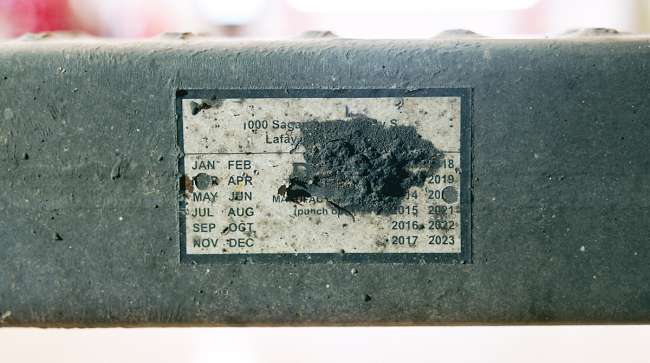Contributing Writer
Trucking Industry Urges FMCSA to End Label Rule

[Stay on top of transportation news: Get TTNews in your inbox.]
For some time, fleet managers have faced the challenges that come with trailer rear-impact guard certification labels. Although small in physical size, the labels often serve as the difference between compliance or violations that can cause big headaches for fleet leadership.
Through the course of a trailer’s time on the road, the labels often are damaged or destroyed by debris and wear and tear. However, manufacturers have been reluctant or unwilling to replace them, putting fleets in the awkward position of either risking a citation or retiring an otherwise-compliant rear-impact guard.
Their concerns had risen to the point that the Commercial Vehicle Safety Alliance petitioned the Federal Motor Carrier Safety Administration earlier last year to rescind its rule concerning the certification labels. FMSCA denied the petition and, in December, announced its guidance that a missing or incomplete trailer rear-impact guard certification label won’t be considered a violation of a rule requiring one to be affixed.
After FMCSA released its guidance, CVSA’s board voted at its December meeting to re-petition the agency to change the rule, said Kerri Wirachowsky, CVSA’s director of inspection programs.
Wirachowsky said the guidance means fleets should not worry about being charged with a violation.

Wirachowsky
“As long as this guidance stays on their website, all is well, to be honest, because this guidance is specifically telling enforcement officers from the federal government not to enforce that section,” she said.
FMCSA’s new guidance, which is similar to CVSA’s policy since 2018, says that illegible, incomplete or missing certification labels do not indicate a guard fails to meet National Highway Traffic Safety Administration strength and energy absorption requirements. Instead, it said inspectors should enforce the rule’s general requirements along with requirements for the guard’s width, height, rear surface and the horizontal member’s cross-sectional vertical height.
“FMCSA is also aware that a motor carrier may be unable to replace an illegible, incomplete, or missing certification label,” the guidance stated.
Asked how and why the agency came to its decision, an FMCSA official wrote in an email, “The agency issued the guidance to encourage state inspectors to focus enforcement efforts on other aspects of the rule, such as guard width and height.”
More Work to Do
Wirachowsky said CVSA still would like a rule change.
“CVSA is going to re-petition the agency to remove that section permanently because guidance can come and go, and guidance is hard to find, and it gets lost,” she said. “So if they are basically saying not to enforce it, then we still want them to remove it from the regulation.”
Kevin Grove, American Trucking Associations director of safety and technology policy, said ATA would like to see a rule change, but that’s a lengthy process. FMCSA took five years to respond to CVSA’s original petition that was submitted in 2019.

Grove
“I think we’d like a permanent solution, but this at least resolves the issue of otherwise missing labels leading to violations when there’s not actually an unsafe condition,” he said.
The regulation requires that trailers with rear-impact guards be affixed with a label with the manufacturer’s name and address, the month and year it was manufactured, and the letters “DOT,” which certify that the guard conforms to federal requirements.
Historically, the rule rarely has been enforced. Data from 2017 and 2018 showed a lack of rear-impact guard violations of any kind, Wirachowsky said, and the citations that did occur often were not specified. Grove said the violation was not readily accessible within the software that inspectors use to document violations. Instead, inspectors would have to handwrite it, so it wasn’t at the top of their minds.
In 2018, CVSA asked inspectors to perform a one-week targeted enforcement blitz that focused on rear-impact guards.
More Calibrate
►Many Paths Can Lead to Fulfilling Truck Technician Career
►Freeze: Verifying Safety of Rear Impact Guards Can Be Complicated
►Legler: TMC Deals With California on ‘Clean Truck Check’
►Baxter: Diesel OEMs Working to Meet 2027 EPA Standards
Officers inspected 10,112 trailers and found 3,170 violations. Of those, 72% were for incomplete or missing labels. More than 2,000 guards were in violation of the certification label requirement. Another 15% were for defective connections and mounting, 7% for improper width, 3% for height, 2% for the guard surface’s rear inset, and 1% for the horizontal beam.
But replacing the labels was challenging, if not impossible. Grove said suppliers either didn’t want to provide labels for used equipment, or they required a time-consuming warranty claim where the asset would be pulled from service until the replacement labels arrived. Some ATA members were asked to sign legal documents. Rear-impact guards manufactured in Canada didn’t have a certification label.
“They knew the condition of that guard when it left the factory,” he said of the manufacturers. “They can’t certify the condition of the guard after it’s been put into use, so they’re not necessarily going to certify something that’s out of their control. So in some cases it wasn’t even possible to get a replacement guard for a U.S. guard that was otherwise compliant. Many of our members thought a large portion of their fleets could be in violation.”
(Transport Topics via YouTube)
CVSA created a policy stating that inspectors should inspect the rear-impact guard’s attachments and horizontal beam. It petitioned FMCSA and NHTSA to rescind the certification rule in 2019. In a letter to NHTSA, Collin Mooney, CVSA’s executive director, argued that the regulation was resulting in inspectors citing rear-impact guards that otherwise met the regulation’s physical requirements.
Wirachowsky said CVSA expected the petition to be granted. It wasn’t. NHTSA said in its denial letter Jan. 30, 2023, that the labels helped identify compliant guards and helped crash investigators determine if a guard had safety defects. FMCSA Deputy Administrator Vincent White wrote in a letter dated Sept. 4, 2024, that when a guard has become damaged beyond repair and is replaced, the label rule ensures the replacement complies with federal requirements.
Fleet Reality
The situation had many real-world implications. Fleets would have had two weeks to rectify and document their compliance, but it was unclear if that would have been enough time. No one had tested the process, which would have been strained with every fleet trying to get replacement labels at once. Violations would affect fleets’ CSA scores, although a label didn’t affect safety. Checking for the label wasn’t even part of annual inspections.
“You could bring in your truck for its annual inspection, pass, and drive it off the lot and immediately get pulled over and get a violation because it doesn’t have that sticker on it, or the metal plate is not readable,” Grove said.
Nussbaum Transportation’s James Grier, director of fleet service, and Tony Morthland, director of maintenance, watched the regulatory process closely. Were the rule enforced, Nussbaum would have had to replace entire bumpers.

Grier
“We’re a smaller fleet, but we’ve got 1,600-1,700 trailers out there, and as these rear-impact guard labels deteriorate, that’s a lot of bumpers we’ve got to end up replacing because it’s a label that we cannot source,” Grier said.
A lot check showed that some of Nussbaum’s rear-impact guards weren’t compliant. Some had stickers, some labels were riveted, and in some the label was missing. None of its suppliers would let it purchase a replacement. Fleet managers discussed installing an outer protective covering on the guards when they arrived. Replacing perfectly fine bumpers would cost thousands of dollars, but leaving things as they were would result in violations that would affect the fleet’s CSA score — a point of pride for the company. There also was the concern that an inspector would deem a sticker illegible that the carrier believed to be in compliance.
The two noted that regulations already exist for the guard’s condition. The carrier maintains the guards and replaces them if cracks appear. Labels won’t last the 10 to 12 years the carrier tries to keep its trailers. Morthland noted that labels were located on the bumper’s right-front side where road debris from the tires was certain to hit them. Simply locating it in the bumper’s center would have helped.
The CVSA board voted to begin advising inspectors to enforce the certification label rule as of Oct. 15 if the federal government didn’t change its stance. Once it had FMCSA’s denial letter, it could not advise officers to not enforce. But it also decided to again communicate with FMCSA about the issue.
Host Seth Clevenger and TT's Connor Wolf discuss CES 2025 and the emerging technologies that could push the trucking industry forward.. Tune in above or by going to RoadSigns.ttnews.com.
In October, CVSA, ATA, and the Owner-Operator Independent Drivers Association met with FMCSA. Going into the meeting, ATA asked members to provide examples of otherwise compliant equipment that had noncompliant labels.
“There were trailers less than a year old where the metal plate was sheened to a mirror shine, just sandblasted due to the normal wear and tear of operational use,” Grove said.
CVSA and trucking industry officials explained to FMCSA how many trucks would be in violation along with fleets’ difficulties acquiring replacement labels. They argued that the rule did not have a safety benefit because it only certified the guard’s manufacturing, not its current condition. Replacing a fully operational guard because of a label problem was a cost that far exceeded the benefits.
The trucking groups asked FMCSA what paths forward existed.
“They advised us that the previous petition was kind of a closed book but that the information that we had presented would warrant a new petition, and that it would be considered. … We had not specifically asked for this discretion, but I think they looked at it internally and decided that it merited some interpretation on their part as well,” Grove said.
Want more news? Listen to today's daily briefing above or go here for more info
With that encouraging dialogue, CVSA board members decided to wait until the December board meeting before advising its inspectors to start enforcing the rule. After the guidance was released Dec. 10, the board decided to maintain the existing policy, and to again petition the agency to change the rule.
Wirachowsky noted the guidance was good news for trucking.
“I had people in the industry lined up,” she said. “I said, ‘You call me the week of the 10th. I’ll tell you what the board’s doing.’ And then they were calling me on the 11th, and I went, ‘I’ve got good news for you. Here’s the guidance.’ ”
Nussbaum’s Grier said that although the regulation won’t be enforced, the fact that it still exists is a concern.
“It’s in the back of our mind so it’s still there, still kind of lingering over us,” he said. “So, it’s still not over yet.”





